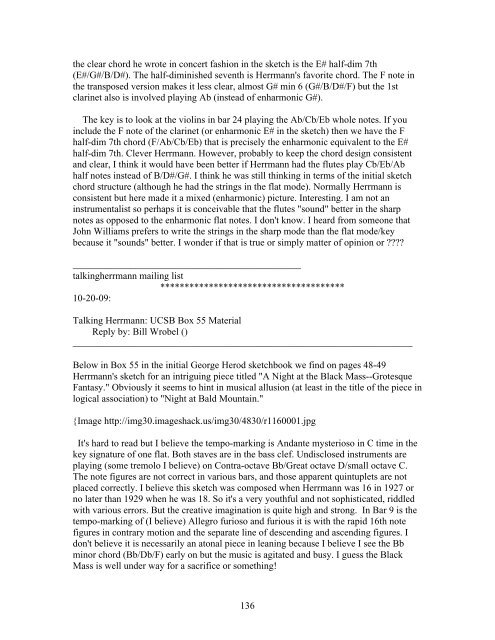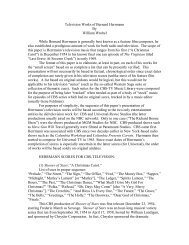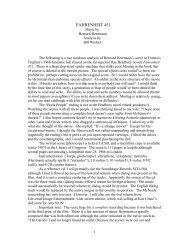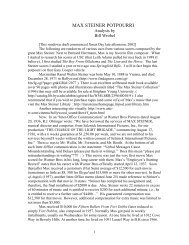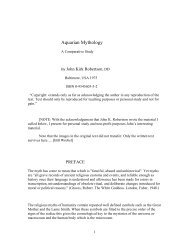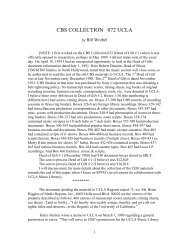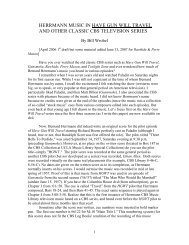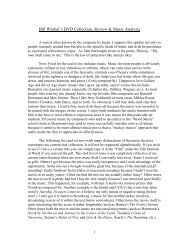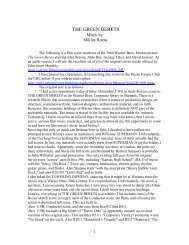Valentine's Day, Sunday, February 14, 2010 at 10:20 am
Valentine's Day, Sunday, February 14, 2010 at 10:20 am
Valentine's Day, Sunday, February 14, 2010 at 10:20 am
- No tags were found...
You also want an ePaper? Increase the reach of your titles
YUMPU automatically turns print PDFs into web optimized ePapers that Google loves.
the clear chord he wrote in concert fashion in the sketch is the E# half-dim 7th(E#/G#/B/D#). The half-diminished seventh is Herrmann's favorite chord. The F note inthe transposed version makes it less clear, almost G# min 6 (G#/B/D#/F) but the 1stclarinet also is involved playing Ab (instead of enharmonic G#).The key is to look <strong>at</strong> the violins in bar 24 playing the Ab/Cb/Eb whole notes. If youinclude the F note of the clarinet (or enharmonic E# in the sketch) then we have the Fhalf-dim 7th chord (F/Ab/Cb/Eb) th<strong>at</strong> is precisely the enharmonic equivalent to the E#half-dim 7th. Clever Herrmann. However, probably to keep the chord design consistentand clear, I think it would have been better if Herrmann had the flutes play Cb/Eb/Abhalf notes instead of B/D#/G#. I think he was still thinking in terms of the initial sketchchord structure (although he had the strings in the fl<strong>at</strong> mode). Normally Herrmann isconsistent but here made it a mixed (enharmonic) picture. Interesting. I <strong>am</strong> not aninstrumentalist so perhaps it is conceivable th<strong>at</strong> the flutes "sound" better in the sharpnotes as opposed to the enharmonic fl<strong>at</strong> notes. I don't know. I heard from someone th<strong>at</strong>John Willi<strong>am</strong>s prefers to write the strings in the sharp mode than the fl<strong>at</strong> mode/keybecause it "sounds" better. I wonder if th<strong>at</strong> is true or simply m<strong>at</strong>ter of opinion or ????_______________________________________________talkingherrmann mailing list**************************************<strong>10</strong>-<strong>20</strong>-09:Talking Herrmann: UCSB Box 55 M<strong>at</strong>erialReply by: Bill Wrobel ()______________________________________________________________________Below in Box 55 in the initial George Herod sketchbook we find on pages 48-49Herrmann's sketch for an intriguing piece titled "A Night <strong>at</strong> the Black Mass--GrotesqueFantasy." Obviously it seems to hint in musical allusion (<strong>at</strong> least in the title of the piece inlogical associ<strong>at</strong>ion) to "Night <strong>at</strong> Bald Mountain."{Image http://img30.imageshack.us/img30/4830/r1160001.jpgIt's hard to read but I believe the tempo-marking is Andante mysterioso in C time in thekey sign<strong>at</strong>ure of one fl<strong>at</strong>. Both staves are in the bass clef. Undisclosed instruments areplaying (some tremolo I believe) on Contra-octave Bb/Gre<strong>at</strong> octave D/small octave C.The note figures are not correct in various bars, and those apparent quintuplets are notplaced correctly. I believe this sketch was composed when Herrmann was 16 in 1927 orno l<strong>at</strong>er than 1929 when he was 18. So it's a very youthful and not sophistic<strong>at</strong>ed, riddledwith various errors. But the cre<strong>at</strong>ive imagin<strong>at</strong>ion is quite high and strong. In Bar 9 is thetempo-marking of (I believe) Allegro furioso and furious it is with the rapid 16th notefigures in contrary motion and the separ<strong>at</strong>e line of descending and ascending figures. Idon't believe it is necessarily an <strong>at</strong>onal piece in leaning because I believe I see the Bbminor chord (Bb/Db/F) early on but the music is agit<strong>at</strong>ed and busy. I guess the BlackMass is well under way for a sacrifice or something!136


